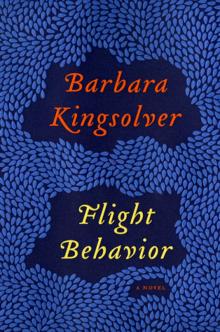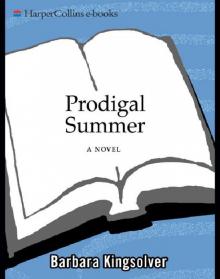- Home
- Barbara Kingsolver
How to Fly (In Ten Thousand Easy Lessons) Page 7
How to Fly (In Ten Thousand Easy Lessons) Read online
Page 7
job is to inherit the earth.
Meekly they wait,
eating their lot of soil
to improve its nature.
Pitilessly they come,
the raiding warriors
six hundred strong
storming the chambers,
crushing pale bodies
to carry off for fodder
but always stopping
short of the full execution.
They leave the queen alive.
The Victorians wrote of
Nature red in tooth and claw,
knowing not the half of it:
still undiscovered, the likes
of the disciplined Matabele
ants that spare the crown;
or the civil virus houseguest
that visits for five days
and then departs before
its sniffling host succumbs.
Nature is nothing if not
a congress of partial kindness.
And who is to say
where cruelty and mercy
may lie down together
to make their mottled children?
In the sickbed from which
the newly hale will rise
and go forth to shed
the seeds of their affliction.
In the throbbing abdomen
of one queen alone
in her darkness, pulsing
eggs, beginning again
the rearing of future
fodder, attuned to a rogue
vibration, listening
for the barbarians at the gate.
Great Barrier
The cathedral is burning. Absent flame or smoke,
stained glass explodes in silence, fractal scales
of angel damsel rainbow parrot. Charred beams
of blackened coral lie in heaps on the sacred floor,
white stones fallen from high places, spires collapsed,
crushing the sainted turtle and gargoyle octopus.
Something there is in my kind that cannot love
a reef, a tundra, a plain stone breast of desert, ever
quite enough. A tree perhaps, once recomposed
as splendid furniture. A forest after the whole of it
is planed to posts and beams and raised to a heaven
of earnest construction in the name of Our Lady.
All Paris stood on the bridges to watch her burning,
believing a thing this old, this large and beautiful,
must be holy and cannot be lost. And coral temples
older than Charlemagne suffocate unattended,
bleach and bleed from the eye, the centered heart.
Lord of leaves and fishes, lead me across this great divide.
Teach me how to love the sacred places, not as one
devotes to One who made me in his image and is bound
to love me back. I mean as a body loves its microbial skin,
the worm its nape of loam, all secret otherness forgiven.
Love beyond anything I will ever make of it.
Forests of Antarctica
From here the oldest trees will speak
to one another in the oldest language,
chemical breath, touch in darkness,
rootlets seeking rootlets holding
hands underground for succor. And I
could pass among them hearing nothing.
Or I could pause on the tilted light
of slate-scrabbled path in a silence
of moss and try to fathom their stillness:
How nothing stirs their hearts.
How patience is a promise a seed makes
to its ground, from the day of cracking
and rooting in, clinging to this escarpment
since before the trial of Socrates, before
the tilting up of plinths at Stonehenge.
Already ringed with moss and age
when Jesus walked out of Nazareth.
Betrothal of these giants to their place
has left them crouched on buttressed trunks
high above the ground, leg-roots exposed
by all the rains that have washed the earth
out from under them since the beginning.
Everything has already happened here.
Still the ancient beeches hold their ground
with moss-knuckled toes, remembering
a Gondwanaland of their youth when
faraway Antarctica was yet a forested nation.
Standing shoulder to shoulder they braced
for the breaking apart of the known,
a rumbling violence of stones, mountain
dashed against mountain, two ships parting.
The trees exhaled in communion, rode their
new continents, survived the end of one world.
In the Great Dividing Range I crave to repent.
In filtered tree fern light I confess the sins
of my tribe: we worship the future, demean
the past, pay no mind to the present.
But a future, cut off from the promise of ever
joining history, lies already dead on its altar
while we chew on our restless feet.
What’s to become of our own seeds
and betrothals: all these floss-haired children
inside us that want to live? Want to move,
stay, eat the soil from under the house,
move on. Want to hold fast but cannot
hold still. I am lifting them up
as newborns to the nursery window
looking out on the forests of Antarctica.
I tell them: This is your home.
Tell them: None of this is yours.
Do not believe as I did. When
the world breaks open, fall apart
with her entrails, fall with the stones or fly.
Let the crush of it make you into some
new thing not yourself. See how these trees
take the teat of the world and suckle it,
drinking time, knowing it is perfect
with or without them. Lacking their religion,
you will have to make your own.
You are the world that stirs. This is the world that waits.
Notes
“How to Fly” borrows an image—the unbodied breath of a bird—from Percy Bysshe Shelley’s “To a Skylark.”
“How to Survive This” was published in the New York Times Magazine, March 26, 2020.
“How to Be Married” is for Rob and Paula Kingsolver.
“How to Love Your Neighbor” is for Frances Goldin.
“How to Be Hopeful,” part of the Duke University commencement address, May 2009, was published in Creating a Life You’ll Love, edited by Mark Chimsky-Lustig (Sellers Publishing, 2009).
The cycle Pellegrinaggio is dedicated con tanto amore to Joann Hopp, who was born (and, frankly, remains) Giovanna Spano.
“This Is How They Come Back to Us” owes its title and spirit to Wendell Berry. The poems in this section are for the dead who are named and the living who bear their losses, especially Anna and Clara Petri, Sara Hopp, Joann Hopp, and Joe Findley.
For “My Mother’s Last Forty Minutes” I’m indebted to my sister, brother, and father, custodians of their own versions of this story, with a nod to William Carlos Williams’s “XXII” from Spring and All.
The italicized lines in “My First Derby Party” are from the song “My Old Kentucky Home,” by Stephen Foster. The poem is dedicated to Fenton Johnson.
“Creation Stories,” “Meadowview Elementary Spelling Bee,” “Blow Me—,” and “After” are for Camille and Lily Kingsolver.
The title “Walking Each Other Home” acknowledges accidental similarity to a quote from Ram Dass, “We are always walking each other home.” The poem is dedicated to Felicia Mitchell.
“Cage of Heaven” borrows images and lines from these poems by Emily Dickinson: “Some keep the Sabbath goi
ng to church,” “I felt a Funeral in my brain,” “Who has not found the heaven below,” “To fight aloud is very brave,” and “A narrow fellow in the grass.”
“Insomniac Villanelle” is for my three A.M. friends, with thanks to Sally Carpenter.
“My Afternoon with The Postman” describes Vincent van Gogh’s portraits of his mail carrier, Joseph Roulin, with thanks to the Barnes Foundation gallery in Philadelphia, where one of these masterpieces hangs unobtrusively in a corner.
“Where It Begins” was previously published in slightly different form in Knitting Yarns, edited by Ann Hood (W. W. Norton, 2014); and The Best American Science and Nature Writing 2014, edited by Deborah Blum and Tim Folger (Houghton Mifflin, 2014). The epigraph is from Sylvia Plath’s poem “Wintering.”
“Ghost Pipes” was published in Orion, Autumn 2020. Ghost Pipes are Monotropa uniflora (also known as corpse plant or Indian pipe), found in woodlands of North America, European Russia, and Asia. The freelance life is never simple.
“Ephemera” is dedicated to the staff and friends of the Blue Ridge Discovery Center in Konnarock, Virginia.
“Love Poem, with Birds” is for Steven Hopp.
“Cradle” is dedicated to Alicia Paghera.
“Mussel, Minnow” lists a few of many deceptions used by American freshwater mussels for the transport of their larvae; for an overview, see “How Mussels Fool Fish into Carrying Their Parasitic Babies,” by Jason Bittel, in National Geographic, November 28, 2017.
“Great Barrier” was published in Time magazine, September 12, 2019. One of its lines echoes the opening of “Mending Wall” by Robert Frost: “Something there is that doesn’t love a wall.”
“Forests of Antarctica” gratefully acknowledges inspiration from the lines “I am the earth that waits. / You are the earth that walks,” from “What the Trail Says,” by Pamela Alexander, in Slow Fire. The referenced trees are Antarctic beeches (Nothofagus moorei) in the Great Dividing Range of Australia, part of the relict Gondwana Rainforest that once dominated Antarctica. They became Australian flora when the two continents separated 180 million years ago. Individual trees on Mount Bithongabel are 2,500 to 3,000 years old, with some cloned groupings estimated to be as old as 15,000 years.
About the Author
BARBARA KINGSOLVER’s books of fiction, poetry, and creative nonfiction are widely translated and have won numerous literary awards. She is the founder of the PEN/Bellwether Prize, and in 2000 was awarded the National Humanities Medal, the country’s highest honor for service through the arts. Prior to her writing career she studied and worked as a biologist. She lives with her husband on a farm in southern Appalachia.
Discover great authors, exclusive offers, and more at hc.com.
Also by Barbara Kingsolver
Fiction
Unsheltered
Flight Behavior
The Lacuna
Prodigal Summer
The Poisonwood Bible
Pigs in Heaven
Animal Dreams
Homeland and Other Stories
The Bean Trees
Essays
Small Wonder
High Tide in Tucson: Essays from Now or Never
Nonfiction
Animal, Vegetable, Miracle: A Year of Food Life (with Steven L. Hopp, Camille Kingsolver, and Lily Hopp Kingsolver)
Last Stand: America’s Virgin Lands (with photographs by Annie Griffiths Belt)
Holding the Line: Women in the Great Arizona Mine Strike of 1983
Copyright
HOW TO FLY (IN TEN THOUSAND EASY LESSONS). Copyright © 2020 by Barbara Kingsolver. All rights reserved under International and Pan-American Copyright Conventions. By payment of the required fees, you have been granted the nonexclusive, nontransferable right to access and read the text of this e-book on-screen. No part of this text may be reproduced, transmitted, downloaded, decompiled, reverse-engineered, or stored in or introduced into any information storage and retrieval system, in any form or by any means, whether electronic or mechanical, now known or hereafter invented, without the express written permission of HarperCollins e-books.
Cover design by Robin Bilardello
Cover photograph © FarukUlay/E+/Getty Images
Originally published as How to Fly in Great Britain in 2020 by Faber and Faber.
FIRST EDITION
Digital Edition SEPTEMBER 2020 ISBN: 978-0-06-299314-4
Version 08112020
Print ISBN: 978-0-06-299308-3
About the Publisher
Australia
HarperCollins Publishers Australia Pty. Ltd.
Level 13, 201 Elizabeth Street
Sydney, NSW 2000, Australia
www.harpercollins.com.au
Canada
HarperCollins Publishers Ltd
Bay Adelaide Centre, East Tower
22 Adelaide Street West, 41st Floor
Toronto, Ontario, M5H 4E3
www.harpercollins.ca
India
HarperCollins India
A 75, Sector 57
Noida
Uttar Pradesh 201 301
www.harpercollins.co.in
New Zealand
HarperCollins Publishers New Zealand
Unit D1, 63 Apollo Drive
Rosedale 0632
Auckland, New Zealand
www.harpercollins.co.nz
United Kingdom
HarperCollins Publishers Ltd.
1 London Bridge Street
London SE1 9GF, UK
www.harpercollins.co.uk
United States
HarperCollins Publishers Inc.
195 Broadway
New York, NY 10007
www.harpercollins.com

 Prodigal Summer: A Novel
Prodigal Summer: A Novel Animal Dreams: A Novel
Animal Dreams: A Novel The Poisonwood Bible
The Poisonwood Bible High Tide in Tucson
High Tide in Tucson The Lacuna
The Lacuna The Bean Trees
The Bean Trees Animal, Vegetable, Miracle: A Year of Food Life
Animal, Vegetable, Miracle: A Year of Food Life Pigs in Heaven
Pigs in Heaven Small Wonder
Small Wonder Flight Behavior
Flight Behavior Homeland and Other Stories
Homeland and Other Stories How to Fly (In Ten Thousand Easy Lessons)
How to Fly (In Ten Thousand Easy Lessons) Unsheltered
Unsheltered Animal Dreams
Animal Dreams Prodigal Summer
Prodigal Summer Animal, Vegetable, Miracle
Animal, Vegetable, Miracle